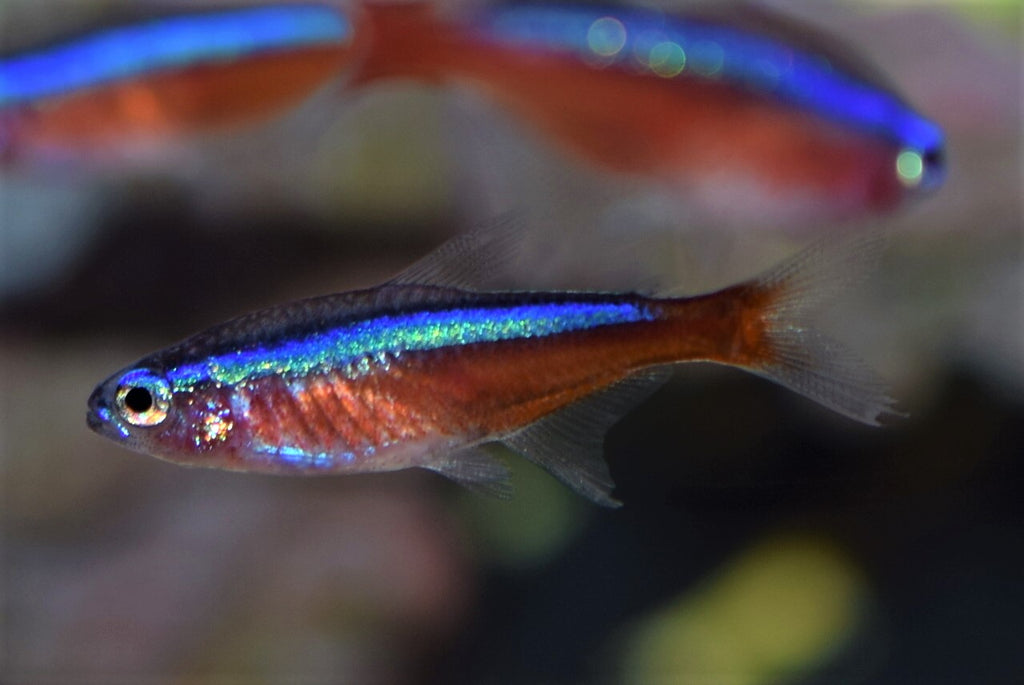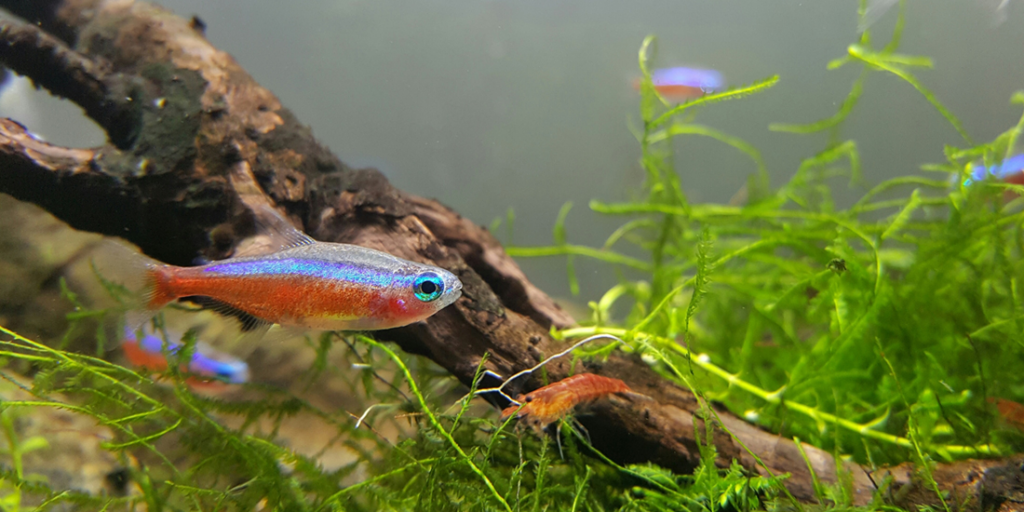Cardinal Tetras (Paracheirodon axelrodi) are stunning and popular aquarium fish known for their vibrant red and blue colors, resembling their close relative, the Neon Tetra.

These small, peaceful fish are native to the blackwater regions of the Amazon River basin. When it comes to aggression, Cardinal Tetras have a reputation for being quite peaceful and generally get along well with other non-aggressive species in a community tank. This article will not only explain the Cardinal Tetra’s temperament but also detail how to care for this great fish!
Cardinal Tetra Behavior
In their natural habitat, Cardinal Tetras prefer to swim in large shoals, where they feel secure and exhibit their most natural behaviors. They are social creatures that thrive when surrounded by their own kind.
Interacting with conspecifics is important for their overall well-being and helps reduce any potential aggression. They are also known to ignore other fish species that do not belong to their shoal in the tank.
Understanding Fish Aggression
Fish aggression is influenced by various factors, including territoriality, mating behaviors, and competition for resources. While aggression is a natural instinct in the animal kingdom, it can be managed and minimized in a well-maintained aquarium.
Cardinal Tetra Aggression

Despite their peaceful reputation, Cardinal Tetras can exhibit aggression under certain circumstances. It’s important to note that aggression in Cardinal Tetras is generally rare, but understanding their triggers can help prevent any potential issues in your aquarium.
One common trigger for aggression in Cardinal Tetras is mating behavior. During the breeding season, males can become territorial and exhibit some aggressive behaviors towards other males competing for females. It’s crucial to provide enough space and hiding spots to reduce the likelihood of aggressive encounters.
Additionally, competition for resources such as food and hiding places can also lead to aggression among Cardinal Tetras. Ensuring that ample food is available and providing suitable hiding spots can help minimize potential conflicts.
In terms of aggression towards other fish species, Cardinal Tetras usually coexist peacefully. As mentioned earlier, they tend to ignore non-related species that are not part of their shoal. However, it’s still important to choose compatible tank mates that share similar temperaments and avoid aggressive or fin-nipping species that may stress or harm the Cardinal Tetras.
Optimal Water Parameters and Tank Setup for Cardinal Tetras
Cardinal Tetras are peaceful species, but maintaining the correct water parameters is crucial to avoid stress-related aggression. These small freshwater fish thrive in soft, acidic water, similar to their natural habitat. Keeping ideal cardinal tetra water parameters supports their immune system, making them less prone to disease and aggression.
Adding floating plants can also provide shelter and reduce stress, helping them feel secure in the tank. These peaceful tetras are compatible with other non-aggressive species, such as Neon Tetras and Diamond Tetras, creating a harmonious community in a well-maintained aquarium.
We recommend using a master test kit like the one form amazon linked below to frequently test your water parameters.
Breeding Behavior of Cardinal Tetras and Use of a Separate Tank
While Cardinal Tetras are generally peaceful, their breeding behavior can sometimes lead to territorial displays. It’s important to use a separate breeding tank to avoid any potential stress or aggression toward other fish.
Cardinal Tetras, along with similar species like Diamond Tetras, exhibit specific behaviors during breeding, which can include chasing or fin nipping. Setting up a dedicated tank for breeding helps minimize disruptions in your main tank and ensures a safe space for both the adult fish and fry.
Do Cardinal Tetras Show Aggression in Smaller Tanks?
Despite being a small fish, Cardinal Tetras can exhibit behaviors similar to aggressive fish when housed in tanks that are too small or overcrowded. Their cardinal tetra size makes them vulnerable to stress, which can lead to aggression if they feel threatened or confined. As a peaceful tetra, providing them with sufficient space and maintaining the right tank conditions is essential to prevent any territorial or aggressive tendencies.

Managing Cardinal Tetra Aggression
Creating a suitable environment is crucial for managing aggression in Cardinal Tetras:
- Ensure the tank is of adequate size to allow for proper shoaling and swimming space.
- Provide plenty of hiding spots such as plants, driftwood, or rocks to create territories and reduce territorial disputes.
- Maintain a varied and nutritious diet for your Cardinal Tetras to minimize competition for food.
- Choose tank mates that have similar temperaments and avoid aggressive or fin-nipping species.
- If aggression issues arise, consider removing the aggressive individual or provide temporary separation.
Conclusion
Although Cardinal Tetras are generally peaceful fish, aggression can arise under certain circumstances. By understanding the triggers and providing a suitable environment, you can create a harmonious community tank where Cardinal Tetras and other fish species can coexist peacefully. Remember to monitor their behavior and address any aggression issues promptly to maintain a healthy and enjoyable aquarium for both you and your fish.



